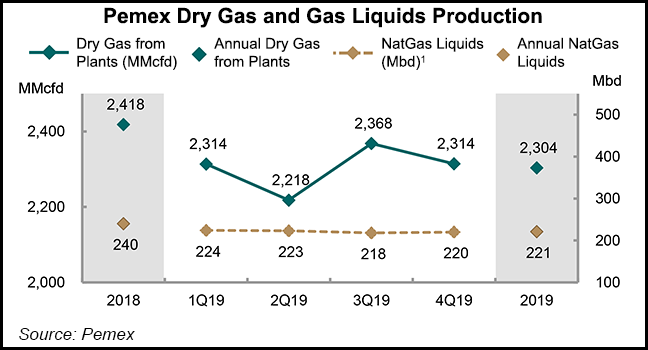Shale Daily | E&P | NGI All News Access | NGI Mexico GPI
Lopez Obrador Government Fails to Change Old Trends at Mexico’s Pemex
Mexico’s state oil and gas giant Petroleos Mexicanos (Pemex) saw 2019 production fall 7% on a year/year comparison to 1.68 million b/d, the company said in its fourth quarter earnings report.

Natural gas production fell slightly to 3.69 Bcf/d in 2019, from 3.84 Bcf/d in 2018.
Pemex posted a net loss of 345.5 billion pesos in 2019, or about $18.3 billion, almost double its 2018 loss. The company also registered a fourth quarter loss of 169.8 billion pesos, its biggest quarterly loss in two years.
The news comes as a significant blow to President Andres Manuel Lopez Obrador, who vowed to “rescue” the state company when he came to power in late 2018. It also comes only days after official 2019 gross domestic product figures showed that Mexico’s economy shrank by 0.49% in 2019. Lopez Obrador had promised annual growth of 4% during his six-year term.
Pemex officials, who did not take questions during their fourth quarter earnings call, highlighted in the presentation the fact that fuel theft fell by 90% in 2019 thanks to efforts to secure key energy infrastructure. They also said January crude production had risen slightly on a year/year basis, attributing the gain to increased well maintenance and completions. There was also no mention during the call of the costly Dos Bocas refinery being built in Lopez Obrador’s home state of Tabasco.
Pemex executives said they were optimistic that the 20 onshore and shallow water fields deemed as high priority would start to see increased production soon. They blamed bad weather, delays in infrastructure and operational problems on delays at the fields, which are seen as a crucial part of the business plan launched last year that seeks to add 1 million b/d crude production and about 1.2 Bcf/d of natural gas by 2024.
Pemex executives said they expect new production at these priority fields to lead to an additional 80,000 b/d by the end of March.
The results may do little to quiet concern of further downgrades to the Pemex credit rating. Last June, Fitch Ratings downgraded Pemex debt to junk status, while Moody’s Investors Service revised its outlook on the state energy giant to negative from stable.
Some analysts said the latest results from Pemex were negative and indicative of the government’s mishandling of the state company and the energy sector, which includes canceling oil rounds and farmouts, as well as abandoning deepwater and unconventional fields.
“They came within $1 billion of matching their performance in 2014, when oil prices collapsed,” energy consultant Gonzalo Monroy told NGI’s Mexico GPI.
Moody’s Investors Service said in a note last Friday it expects Pemex crude oil production to rise by 1% in 2019. If Pemex were to fulfill the projection of a 1% increase, 2020 output would average some 1.7 million b/d in 2020, well below the 1.87 million b/d originally forecast by Pemex in its 2019-2023 business plan.
Moody’s highlighted that oil production remained essentially flat in 4Q2019 compared to 3Q2019, “demonstrating good progress” on Pemex’s “key objective to stabilize production.” However, low oil prices and delays at priority fields will likely prove challenging obstacles to overcome this year, according to market observers.
“For 2020, Pemex’s investment budget amounts to $16.7 billion, of which 81% would be allocated to exploration and production,” Moody’s researchers said, “although in the past the company has invested much less than planned and such [a] high amount of capital expenditure would require much higher crude and fuel prices…”
Export revenues for the state-owned firm declined by 16.5% in 2019 as the Mexican crude oil basket averaged $55.63/bbl, down 9.4% y/y.
“I think that is perhaps the biggest warning sign about what they’re trying to do,” Monroy said, explaining that “Pemex’s cost structure…is quite rigid and has not been able to adjust downward.”
Monroy said that lower oil prices in 2020 would “only amplify the losses that we saw last year.”
The Ixachi field, meanwhile, the only major natural gas project in Pemex’s upstream portfolio, is “completely behind schedule” due to its technical complexity, Monroy said.
Pemex’s total debt stood at 1.98 trillion pesos as of end-2019, or about $101 billion at the current exchange rate, down from 2.08 trillion pesos at the end of 2018.
Monroy said he thinks a subsequent downgrade by another ratings agency in 2020 “is already a given.” He is “not sure if it’s completely priced in yet, but I tend to believe that this will be the year…when it will become evident that oil production is not increasing,” and that the Dos Bocas oil refinery “will not be completed in due time…”
© 2024 Natural Gas Intelligence. All rights reserved.
ISSN © 2577-9877 | ISSN © 2577-9966 | ISSN © 2158-8023 |
